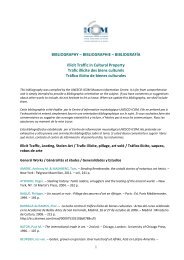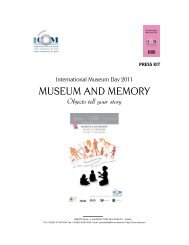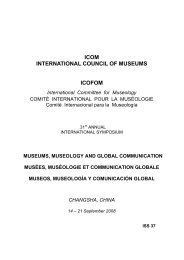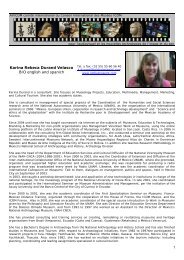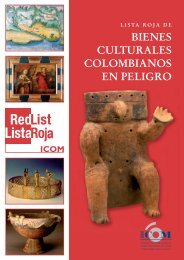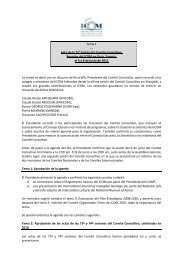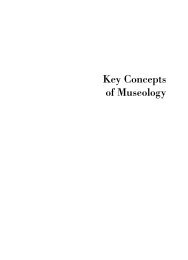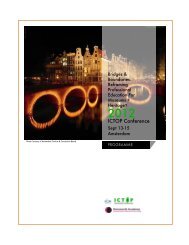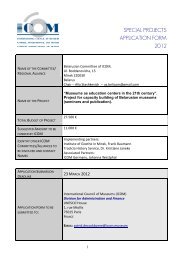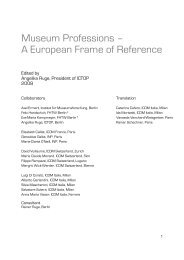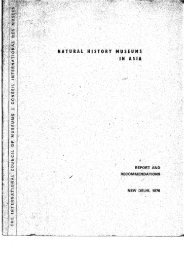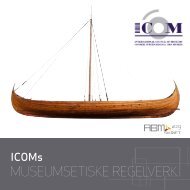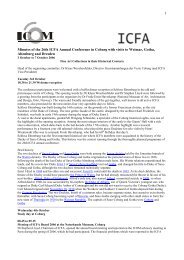ISS 25 (1995).pdf - The International Council of Museums
ISS 25 (1995).pdf - The International Council of Museums
ISS 25 (1995).pdf - The International Council of Museums
Create successful ePaper yourself
Turn your PDF publications into a flip-book with our unique Google optimized e-Paper software.
In these last ten years I have mainly worked with people and their attitudes to<br />
their own community and history. <strong>The</strong> frame <strong>of</strong> our Jives consists <strong>of</strong> a<br />
dramatic scenery, water power as a key resource, modern technology and 3<br />
big factories producing zinc, titanium oxide/high quality iron and calcium<br />
carbide/dicyandianide. <strong>The</strong> community has 8000 inhabitants. <strong>The</strong> place<br />
Tyssedal was at the turn <strong>of</strong> the century merely a crack in the mountain with<br />
two farms. In 1906 it changed to become the largest construction site in the<br />
country. In 1918 Tyssedal was a small town with a big power station as its<br />
heart. Through water power and electricity Tyssedal and Norway became a<br />
modern affluent society. This is the story <strong>of</strong> a rural village and an<br />
internationally known tourist resort that changes overnight to become an<br />
industrial town. It is the story <strong>of</strong> modernization and the story <strong>of</strong> women, men<br />
and children that moved to Odda.<br />
<strong>The</strong> society is the raw material <strong>of</strong> the Western Norway Industrial Museum.<br />
<strong>The</strong> museum has gradually grown to what it is today, located in a living<br />
industrial society where boats from all over the world come and go with raw<br />
material and produce for export.<br />
Today the museum is one <strong>of</strong> the largest in Norway on the subject <strong>of</strong> water<br />
power. We show exhibitions on man in the industrial society, the history <strong>of</strong> the<br />
environmental problems and the history <strong>of</strong> technology. We have archives<br />
where information from the organizations and factories are collected and used<br />
for research. Furthermore we have a film room with slides shows specially<br />
designed to depict our history, and 3 workmen's dwellings, one <strong>of</strong> which<br />
shows different interiors up to the 1990's. Finally the museum arranges guided<br />
tours in the footsteps <strong>of</strong> the pioneer workers and to the industrial monuments<br />
inside and outside the factories and the power station.<br />
Hardanger is internationally known as an idyllic tourist resort. <strong>The</strong> glaciers,<br />
the waterfalls, the blue-green fjord and the apple blossom make the scenery <strong>of</strong><br />
Hardanger look like a romantic poem. I am now going to take you to a<br />
different and dramatic Hardanger where the mountains are high and the<br />
valleys deep.<br />
Tyssedal in Hardanger has another tone and rhythm, namely that <strong>of</strong> a shift<br />
working society, a town <strong>of</strong> smelting works, heat and electricity.<br />
As I mentioned previously, I was, as a student, familiar with the idea <strong>of</strong> the<br />
ecomuseum; to preserve buildings and objects on their original site or<br />
environment rather than moving everything to a museum building or a<br />
museum area, and to document and explain how man coped with nature. Now<br />
I had the opportunity to create a museum, a place where people were<br />
encouraged to engage themselves in history, in the local community and<br />
contemporary life and issues. To my mind a modern museum is interesting<br />
only when the audience - the visitors- engage themselves and are participants<br />
196



